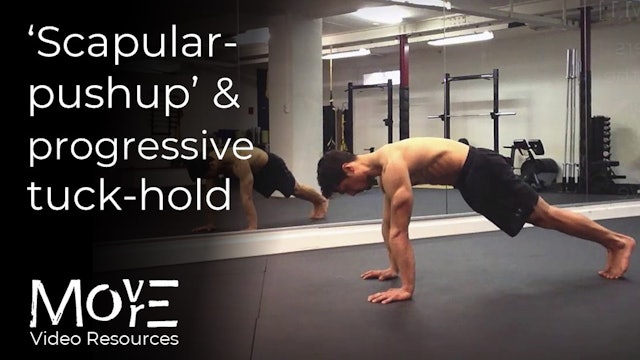-
The 'Hollow-Body'
THE WHAT:
A foundational bodyweight strength exercise which develops transferable understanding and conditioning of the fundamental "hollow-body" position. This characteristically globally-concaved structure is fundamental in that it produces maximal TENSION in the body, radiating from the inside... -
‘Superman’ isometric & pushups
THE WHAT:
A prone, floor-based global-stability drill performed in either an isometric hold or “pushups” variation. Its optimal execution relies on an EMBODIED understanding of the "hollow-body" form, namely sustaining a strong 'neutral' spine-position through conscious posterior pelvic-tilt ('PP... -
Progressive 'Dragon-flag' & variations
THE WHAT:
The 'Dragon-flag' form is a progressive, bent-arm lever form which both develops & conditions global structural-stability, namely strength to stabilise the spine ("core-strength") under increasingly unfavourable leverage. With the "hinge" at the shoulders, everything shoulders-down serv... -
Rings 'roll-out'
THE WHAT:
A simple & convenient global-stability drill performed with the gymnastics rings. Its optimal execution relies on an EMBODIED understanding of the "hollow-body" form, namely sustaining a strong 'neutral' spine-position through conscious posterior pelvic-tilt ('PPT') & supported by activ... -
'Table-top' isometric variations
THE WHAT:
A fundamental straight-arm shoulder-extension context for mobility, strength, and structural-balance development (i.e. to "balance out" overhead pushing/shoulder-flexion contexts).Whilst the fundamental bilateral context (i.e. both hands & feet on the ground) helps to diagnose, develo...
-
Fundamental "Animal Box" transition
THE WHAT & HOW:
The '"Animal box" allows for a quick & simple transition between prone & supine quadrupedal positions. In incorporating with wider quadrupedal locomotion vocabulary, it most notably allows for seamless switching between variations of the 'Bear crawl' (prone) and the 'Crab/table wa... -
'Scapular Pushup' & progressive 'Tuck-hold'
THE WHAT (SCAPULAR-PUSHUP):
An upper-body mobilization, neuro-muscular & strength-development context form which expresses straight-arm scapular/strength (SAS/S), in horizontal pushing.Structurally, it represents and practices a global "hollow" of the body (slight flexion from head-to-toes, lik...
-
From knee-raise to knee-to-bar
THE WHAT & HOW:
Linear progressions for developing strength & patterning for straight-arm pulling, incorporating both straight-arm scapular-strength (SASS) and straight-arm strength (SAS).Particularly from the initial 'Knee-raise' progression, the ultimate objective should be kept in mind throu...
-
Rings ‘Knee-raise’ to ‘Toes to rings’
THE WHAT & HOW:
Linear progressions for developing strength, patterning, and familiarity with straight-arm pulling on the gymnastics rings, affecting both straight-arm scapular-strength (SASS) and straight-arm strength (SAS).Along with variations of ‘Knee-to-bar’, this conditioning context emph...
-
Loaded-carrying contexts
THE WHAT:
Lifting a heavy load, and walking. Two fundamental facts of life which, at first glance, can seem of insufficient intensity to compare to the likes of a 'Back squat' or 'Deadlift' - but there is a reason why forms of loaded-carrying are a staple of all 'Strongman' events.The load can ...
-
The fundamental 'AG support'
THE WHAT & HOW:
The 'AG ('Artistic gymnastics') support' position allows for the development of strength to PULL and support oneself in the ranges of shoulder-extension. This is as opposed to the more passive range which is develop in shoulder-extension contexts, such as the 'German hang' positio... -
Floor 'Butcher's block'
THE WHAT & HOW:
A fundamental & easily accessible context for development of the 'open-shoulder' position (facilitating overhead arm-flexion range) in a loaded, isometric context. As part of its form & execution, the 'hollow-body' position is also drilled & conditioned in a prone position, resist... -
'Iron-cross' pushups
THE WHAT:
A linearly-developmental, horizontal pushing frame in the sagittal plane for strength & stability development. It allows the practitioner to explore & develop the more "open" ranges (i.e. elbow-angle) of bent-arm strength and integrating with straight-arm strength (in entering the top, ... -
Lying waist-rotations
THE WHAT & HOW:
The lying waist rotation is an isolated context to both explore and develop transverse rotational-range of the trunk and, when optimally executed, spinal stability. It is concerned with manipulating the weight of the legs in space using INTRINSIC strength and adherence to "quality... -
'Passive' & 'Active' hanging 'L-sit'
THE WHAT:
Fundamental "core" and straight-arm scapular-strength (SASS) development contexts affected by lifting & extending of the legs toward a full 'L-sit' form, and holding isometrically. At the same time, it also teaches basic manipulation of 'mechanical advantage' with the legs; essentially ... -
L-sit to V-sit progression
THE WHAT & HOW:
'THE L-SIT' represents another fundamental bodyweight-strength (BWS) form whereby the load of the body in its entirety is held off of the floor. That it begins in a seated position and utilises a scapular pushing mechanic with much greater "real-world" application than other BWS f... -
'Bottom-up' & 'Dynamic' FL-pulls
THE WHAT:
As a straight-arm strength (SAS) form, the 'Front-lever' (FL) develops the capacity to withstand isometrically & "pull" one’s bodyweight in & out of a position of hanging shoulder-flexion, i.e. with the straight-arms in FRONT of the medial-line of the body.Whilst this has application ...
-
'Windshield-wipers' (WW) & 'Meathook' (MH)
THE WHAT:
Both contexts exploring hanging transverse-rotation in a "piked" front-lever form, the 'Windshield wipers' (WW) are a patterning & conditioning context, whilst the 'Meathook' (MH) is an isometric-form which might well be classed as a skill.For this reason they cannot really be seen as...




















